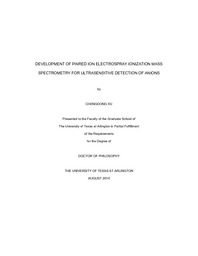
ATTENTION: The works hosted here are being migrated to a new repository that will consolidate resources, improve discoverability, and better show UTA's research impact on the global community. We will update authors as the migration progresses. Please see MavMatrix for more information.
Show simple item record
| dc.contributor.author | Xu, Chengdong | en_US |
| dc.date.accessioned | 2014-09-17T17:28:49Z | |
| dc.date.available | 2014-09-17T17:28:49Z | |
| dc.date.issued | 2014-09-17 | |
| dc.date.submitted | January 2014 | en_US |
| dc.identifier.other | DISS-12750 | en_US |
| dc.identifier.uri | http://hdl.handle.net/10106/24706 | |
| dc.description.abstract | Mass spectrometry (MS) has emerged as an essential analytical technique over the last several decades. It is a widely applicable and powerful tool for determination and identification of different types of molecules. Electrospray ionization (ESI) is one of the most commonly used ionization sources for mass spectrometry. ESI-MS has advantages for the analysis of both small molecules and macromolecules due to its outstanding sensitivity, specificity, speed, and the capability for analyte structure elucidation. Currently, one challenging aspect in ESI-MS is the qualitative and quantitative determination of anionic species. This is due to the inherently poor detection sensitivity in the negative ion mode ESI-MS resulting from the prevalent electrical discharge (corona discharge). This dissertation discusses the development of a novel technique named paired ion electrospray ionization mass spectrometry (PIESI-MS) for the ultrasensitive determination of anions in the positive ion mode ESI-MS. PIESI-MS involves introducing low concentrations of structurally optimized ion-pairing reagents (IPRs) into the sample flow, thereby allowing the anions to be measured with extremely high sensitivity in the positive ion mode as the anion/IPR associated complexes. The reported LODs by PIESI-MS were usually from 2 to 3 orders of magnitude better than these of other known methods.Specifically, this dissertation describes research in two areas:1). Novel methodologies, based on HPLC-PIESI-MS, were developed and evaluated for the trace analysis of anionic molecules. The PIESI-MS approach was found to be suitable for ultrasensitive determination of a variety of molecules, including small inorganic anions, medium sized organic anions, zwitterionic molecules, and metal cations. The absolute detection limits (LODs) of these analytes obtained using the PIESI-MS approach were determined in both single ion monitoring mode (SIM) and selected reaction monitoring mode (SRM). LODs from sub-picogram to picogram were usually observed for most of the anions, which indicates 2 to 3 orders of magnitude improvement compared to most other reported methods. The accuracy, precision, linearity, and specificity were also evaluated as a part of method validation. SRM fragmentation pathways of the analyte/IPR complexes during the collision induced dissociation were examined.2). Novel unsymmetrical dicationic ion-pairing reagents were rationally synthesized and their performance on detection of anions by PIESI-MS were investigated. It was found that the unsymmetrical dications provided more sensitive detection by 1.5 to 12 times than their symmetrical dication analogues. The effective concentration range of the unsymmetrical dicationic ion-pairing reagents was optimized. A correlation was observed between the ESI response and the surface activity of the anion/IPR complex, which indicates that the analyte surface activity plays a vital role in the electrospray ionization process. The sensitivity enhancement mechanism in PIESI-MS was further explored based on the concepts of the equilibrium partitioning model. | en_US |
| dc.description.sponsorship | Armstrong, Daniel | en_US |
| dc.language.iso | en | en_US |
| dc.publisher | Chemistry & Biochemistry | en_US |
| dc.title | Development Of Paired Ion Electrospray Ionization Mass Spectrometry For Ultrasensitive Detection Of Anions | en_US |
| dc.type | Ph.D. | en_US |
| dc.contributor.committeeChair | Armstrong, Daniel W. | en_US |
| dc.degree.department | Chemistry & Biochemistry | en_US |
| dc.degree.discipline | Chemistry & Biochemistry | en_US |
| dc.degree.grantor | University of Texas at Arlington | en_US |
| dc.degree.level | doctoral | en_US |
| dc.degree.name | Ph.D. | en_US |
Files in this item
- Name:
- Xu_uta_2502D_12750.pdf
- Size:
- 4.725Mb
- Format:
- PDF
This item appears in the following Collection(s)
Show simple item record


